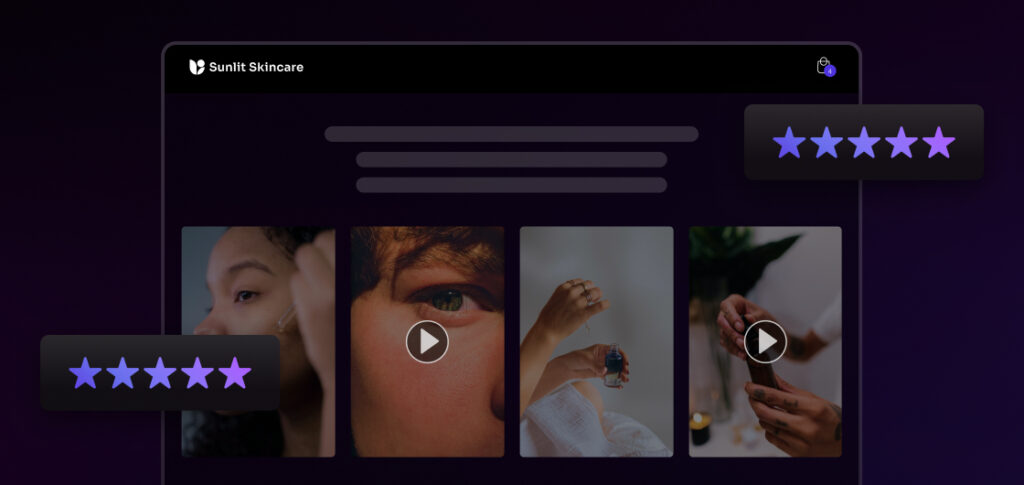
- Customer Marketing
- Reviews and UGC
- Social Proof
How To Add Social Proof on Shopify
Katie Vaught | Apr 25, 2025
Oct 30, 2023 | 10 minute read
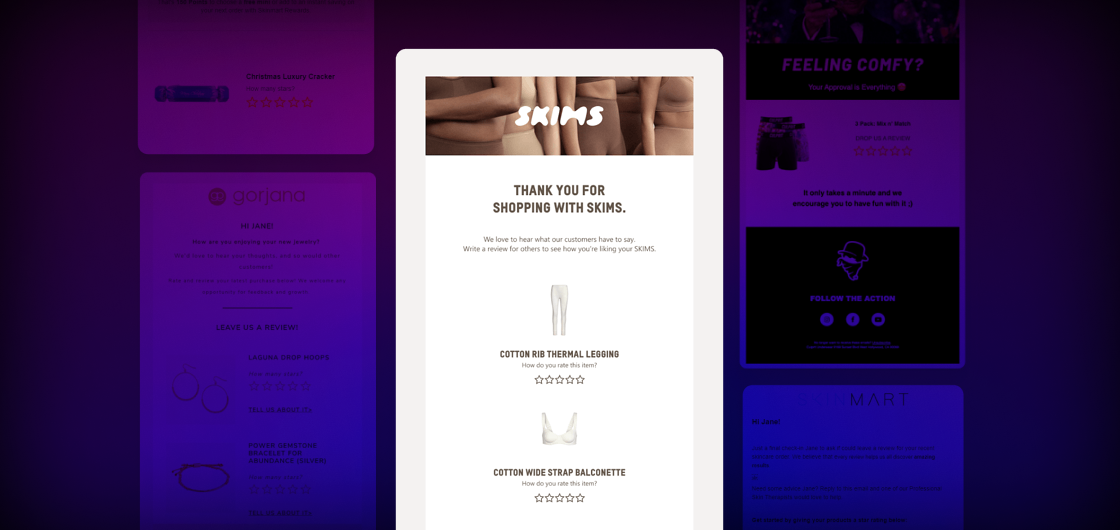
Megan Wenzl
Content Marketing Manager
According to Okendo’s research on ecommerce trust, 95% of consumers believe reviews are important when making a purchase decision, with a significant portion (34%) asserting that they are “extremely” important.
Although this data is an important reminder of the value of customer reviews for your brand, it isn’t all that surprising. We know online reviews wield immense power. They can make or break your business, influence purchasing decisions, and shape your company’s reputation. The bigger, and perhaps more urgent question to ask yourself is this: How do I go about generating reviews without feeling pushy or intrusive?
If this question is top of mind for your brand, you’ve come to the right place. In this blog, we describe exactly how to request reviews from your customers without turning into that annoying brand that won’t leave their inbox. To make this an easy-to-follow guide, we’ll also show real-life examples of review request emails from some of the fastest-growing brands.
By the end of this blog, you’ll know exactly what to do to encourage more customer feedback. First, though, let’s remind ourselves why it’s important to ask customers for reviews.
Since the boom of ecommerce, the role of customer reviews have skyrocketed in importance. Beyond serving as mere testimonials, customer reviews hold enormous influence, helping potential buyers make informed decisions and forming the backbone of trust in online commerce. Here are a few reasons why you should actively seek out reviews from your customers.
For additional insights and tips to help you make the most of your customer reviews, read: Maximize Review Generation, Increase Your Conversion Rate.
Here’s how to make the most of asking customers for reviews:
When it comes to asking customers for reviews, your choice of words and the tone you use can make all the difference. If you’re too pushy, your customers might be put off. But if you’re too vague, they won’t know what you want them to do.
To stand out and encourage customers to share their experiences, it’s time to get creative with your copy. When you’re asking for reviews, the last thing you want to do is sound like a faceless corporation. You might consider using humor or memorable catchphrases to make your request more memorable. Or, just use a conversational and friendly tone that aligns with your brand’s personality.
Not only does the above create a deeper connection with your customers and show off your personality, it nudges them in the right direction so they don’t leave without having their say.
Culprit Underwear injects personality into their review request emails. See how they use they use their brand’s personality to grab the shopper’s attention.
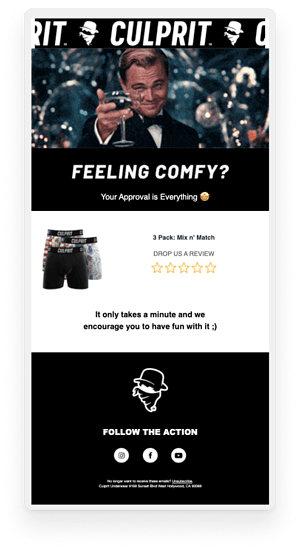
Customers crave personalized experiences. Generic, one-size-fits-all requests for reviews often fall flat. To truly connect with your customers and increase the likelihood of them leaving reviews, you need to personalize your communications.
A simple yet effective way to personalize your communication is by addressing your customers by their first names. Starting your message with a warm greeting like “Hi [Customer’s Name],” instantly adds a personal touch. It shows that you value the individual behind the email or message and aren’t just sending out mass requests. You’ll be able to quickly build trust and drive more engagement as a result.
You can also demonstrate that you’ve been paying attention to your customers’ interactions with your business. Mention specific products they’ve purchased or services they’ve used. Personalizing your communications shows your customers that you see them as individuals, not just numbers in your database. It fosters a sense of connection and trust, making them more likely to respond positively to your review requests.
Who doesn’t love a good deal?
Offering rewards can be an effective way to incentivize your customers to take the time and effort to share their thoughts. Rewarding customers with a discount code can give them the push they need to leave a review. It also nurtures long-term buyer relationships and increases customer retention. Feastables leverages the power of rewards to entice customers to leave high-quality reviews. Reviewers who leave a video with their review are offered a discount on a future order. This powerful UGC builds trust with potential customers, helps them make purchasing decisions, and has resulted in a 433% increase in conversions.
Maintaining consistency with your brand identity when asking for customer reviews is essential to a consisten customer experience. Your brand is more than just a logo or a color scheme; it’s the personality and values that define your brand. This is why brand identity is so important — it drives how your customers see your brand and how they feel when they interact with you. In return, developing a strong recognition of your brand amongst customers helps build trust and credibility.
When a customer opens your review request email, you want them to know immediately who it’s from. This is why you should align your messaging and approach with your brand when requesting reviews. Not only does it foster a sense of familiarity, but it creates a more cohesive and authentic customer experience.
SKIMS embeds its world-famous brand identity into its review request emails. When customers open their inbox, there’s no doubt who’s reaching out. They immediately recognize its neutral brand colors and unique logo.
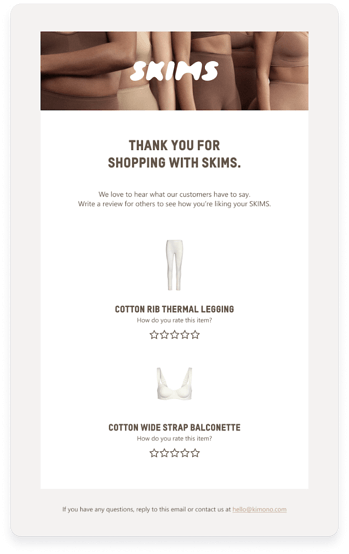
Timing is crucial when it comes to asking customers for reviews. Sending your review requests at the right moment can significantly impact the likelihood of a positive response.
To get the best results, it’s crucial that you find the sweet spot for sending your request emails. Consider where the customer is in their journey with your product or service. Sending a review request immediately after purchase or interaction may not be ideal, as the customer might not have had enough time to form an opinion. It’s often better to wait until they’ve had a chance to use the product or service and derive value from it. This could be a few days or weeks after their initial experience.
For example, Skinmart waits 31 days before sending the first review request template, which is enough time for the customer to receive and try the product.
The brand then waits another seven days to send an email to customers who failed to leave a review after the first ask. This gives the customer another opportunity to leave a review at a new time that might be more convenient for them.
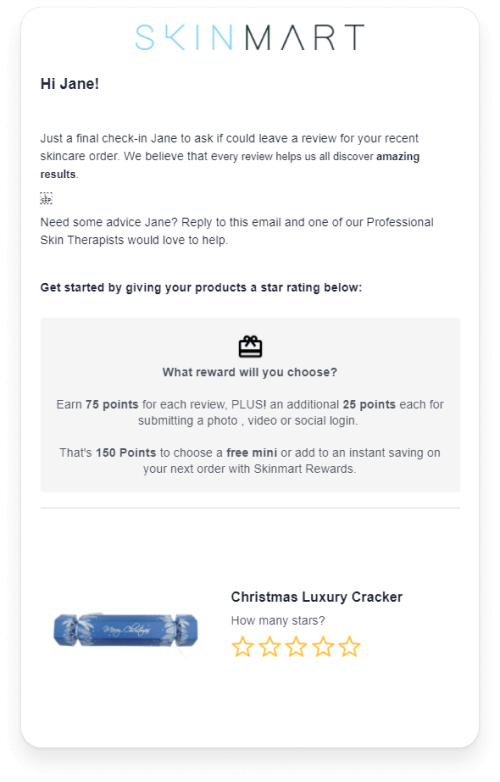
Another brand, Vegamour, uses data in Okendo to accurately time when to send requests based on how long the customer has been using a particular product. For example, for their gray hair products, they wait three months to send a review request since that’s how long it typically takes for customers to see results.
Not every customer will be ready to give 5-stars. They might not have received the product, it might be damaged by delivery, or it might not be what they were expecting.
Use this opportunity to get feedback and give customers a chance to improve their experience. This will avoid low-star reviews because you’ll have a chance to correct things first.
Gorjana achieves this by including customer support contact details in its review emails. Its review request emails clearly communicate the importance of great customer experiences, and give unsatisfied shoppers an opportunity to speak up if their experience with Gorjana fell below their expectations.
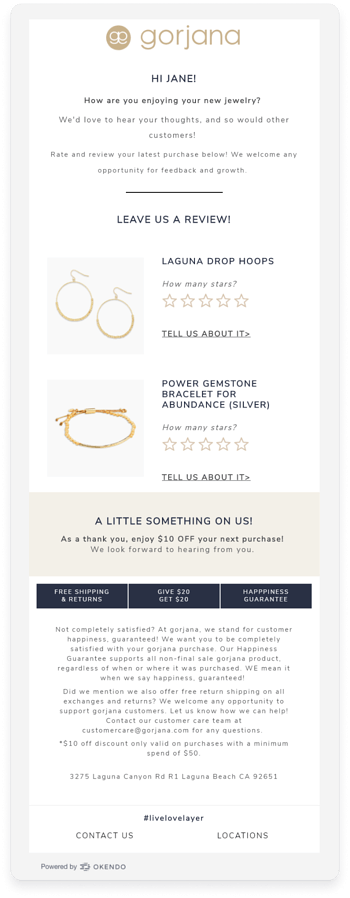
Okendo Reviews simplifies the process of requesting and showcasing high-impact social proof, making it seamless and efficient for both you and your customers.
Using an all-in-one customer marketing platform, you can craft and compelling review requests and automate follow-ups. We also give you the tools to showcase your reviews in engaging ways to build trust and drive conversions. By streamlining the review generation process, Okendo empowers you to maximize lifetime value, cultivate advocacy, and drive fast and efficient growth.
Related articles
Ready to learn more?